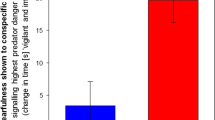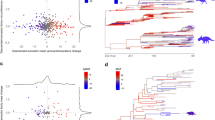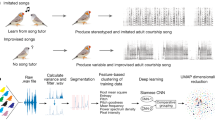Abstract
Sexually selected weapons evolved to maximize the individual reproductive success of males in many polygynous breeding species. Many weapons are also retained outside of reproductive periods for secondary reasons, but the importance of these secondary functions is poorly understood. Here we leveraged a unique opportunity from the predator–prey system in northern Yellowstone National Park, WY, USA to evaluate whether predation by a widespread, coursing predator (wolves) has influenced a specific weapon trait (antler retention time) in their primary cervid prey (elk). Male elk face a trade-off: individuals casting antlers early begin regrowth before other males, resulting in relatively larger antlers the following year, and thus greater reproductive success, as indicated by research with red deer. We show, however, that male elk that cast their antlers early are preferentially hunted and killed by wolves, despite early casters being in better nutritional condition than antlered individuals. Our results run counter to classic expectations of coursing predators preferring poorer-conditioned individuals, and in so doing, reveal an important secondary function for an exaggerated sexually selected weapon—predatory deterrence. We suggest this secondary function played a key evolutionary role in elk; uniquely among North American cervids, they retain their antlers long after they fulfil their primary role in reproduction.
This is a preview of subscription content, access via your institution
Access options
Access Nature and 54 other Nature Portfolio journals
Get Nature+, our best-value online-access subscription
$29.99 / 30 days
cancel any time
Subscribe to this journal
Receive 12 digital issues and online access to articles
$119.00 per year
only $9.92 per issue
Buy this article
- Purchase on Springer Link
- Instant access to full article PDF
Prices may be subject to local taxes which are calculated during checkout

illustration by E. Harrington, Missoula, MT, USA.



illustration by E. Harrington, Missoula, MT, USA.
Similar content being viewed by others
Data availability
Data used for analyses is available at https://datadryad.org/resource/doi:10.5061/dryad.j72tt79.
References
Emlen, S. T. & Oring, L. W. Ecology, sexual selection, and the evolution of mating systems. Science 197, 215–223 (1977).
Clutton-Brock, T. H. Reproductive Success: Studies of Individual Variation in Contrasting Breeding Systems (Univ. Chicago Press, Chicago, IL, 1988).
Darwin, C. The Descent of Man, and Selection in Relation to Sex (John Murray, London, 1871).
Andersson, M. Sexual Selection (Princeton Univ. Press, Princeton, NJ, 1994).
Godin, J.-G. J. & McDonough, H. E. Predator preference for brightly colored males in the guppy: a viability cost for a sexually selected trait. Behav. Ecol. 14, 194–200 (2003).
Johnson, S. & Candolin, U. Predation cost of a sexual signal in the threespine stickleback. Behav. Ecol. 28, 1160–1165 (2017).
Stuart-Fox, D. M., Moussalli, A., Marshall, N. J. & Owens, I. P. F. Conspicuous males suffer higher predation risk: visual modelling and experimental evidence from lizards. Anim. Behav. 66, 541–550 (2003).
Goyens, J., Dirckx, J. & Aerts, P. Costly sexual dimorphism in Cyclommatus metallifer stag beetles. Funct. Ecol. 29, 35–43 (2015).
Bildstein, K. L., McDowell, S. G. & Brisbin, I. L. Consequences of sexual dimorphism in sand fiddler crabs, Uca pugilator: differential vulnerability to avian predation. Anim. Behav. 37, 133–139 (1989).
McLain, D. K., Pratt, A. E. & Berry, A. S. Predation by red-jointed fiddler crabs on congeners: interaction between body size and positive allometry of the sexually selected claw. Behav. Ecol. 14, 741–747 (2003).
Bro-Jørgensen, J. The intensity of sexual selection predicts weapon size in male bovids. Evolution 61, 1316–1326 (2007).
Clutton-Brock, T. H., Albon, S. D. & Harvey, P. H. Antlers, body size and breeding group size in the Cervidae. Nature 285, 565–567 (1980).
Coltman, D. W., Festa-Bianchet, M., Jorgenson, J. T. & Strobeck, C. Age-dependent sexual selection in bighorn rams. Proc. R. Soc. Lond. B 269, 165–172 (2002).
Kruuk, E. B. et al. Antler size in red deer: heritability and selection but no evolution. Evolution 56, 1683–1695 (2002).
Goss, R. J. Deer Antlers: Regeneration, Function and Evolution (Academic, New York, NY, 1983).
Lincoln, G. A. Biology of antlers. J. Zool. 226, 517–528 (1992).
Price, J. & Allen, S. Exploring the mechanisms regulating regeneration of deer antlers. Phil. Trans. R. Soc. Lond. B 359, 809–822 (2004).
Clutton-Brock, T. H., Albon, S. D., Gibson, R. M. & Guinness, F. E. The logical stag: adaptive aspects of fighting in red deer (Cervus elaphus L.). Anim. Behav. 27, 211–225 (1979).
Malo, A. F., Roldan, E. R. S., Garde, J., Soler, A. J. & Gomendio, M. Antlers honestly advertise sperm production and quality. Proc. R. Soc. Lond. B 272, 149–157 (2005).
Vanpé, C. et al. Antler size provides an honest signal of male phenotypic quality in roe deer. Am. Nat. 169, 481–493 (2007).
Clements, M. N., Clutton-Brock, T. H., Albon, S. D., Pemberton, J. M. & Kruuk, L. E. B. Getting the timing right: antler growth phenology and sexual selection in a wild red deer population. Oecologia 164, 357–368 (2010).
Bartoš, L. The date of antler casting, age and social hierarchy relationships in the red deer stag. Behav. Processes 5, 293–301 (1980).
Bowyer, R. T. Antler characteristics as related to social status of male southern mule deer. Southwest. Nat. 31, 289–298 (1986).
Van Ballenberghe, V. in Antler Development in Cervidae (ed. Brown, R.D.) 37–48 (Caesar Kleberg Wildlife Research Institute, Kingsville, TX, 1983).
Chapman, D. I. Antlers–bones of contention. Mamm. Rev. 5, 121–172 (1975).
Polziehn, R. O. & Strobeck, C. A phylogenetic comparison of red deer and wapiti using mitochondrial DNA. Mol. Phylogenet. Evol. 22, 342–356 (2002).
Meiri, M. et al. Subspecies dynamics in space and time: a study of the red deer complex using ancient and modern DNA and morphology. J. Biogeogr. 45, 367–380 (2018).
Allen, B. J. & Levinton, J. S. Costs of bearing a sexually selected ornamental weapon in a fiddler crab. Funct. Ecol. 21, 154–161 (2007).
Clutton-Brock, T. H. The functions of antlers. Behaviour 79, 108–125 (1982).
Bobek, B., Perzanowski, K. & Weiner, J. Energy expenditure for reproduction in male red deer. J. Mammal. 71, 230–232 (1990).
Rughetti, M. & Festa-Bianchet, M. Seasonal changes in sexual size dimorphism in northern chamois. J. Zool. 284, 257–264 (2011).
Geist, V. New evidence of high frequency of antler wounding in cervids. Can. J. Zool. 64, 380–384 (1986).
Owen-Smith, N. Changing vulnerability to predation related to season and sex in an African ungulate assemblage. Oikos 117, 602–610 (2008).
Packer, C. Sexual dimorphism: the horns of African antelopes. Science 221, 1191–1193 (1983).
Clements, H. S., Tambling, C. J. & Kerley, G. I. H. Prey morphology and predator sociality drive predator prey preferences. J. Mammal. 97, 919–927 (2016).
Peterson, R. O. Wolf Ecology and Prey Relationships on Isle Royale (US Government Publishing Office, Washington, DC, 1977).
Fitzgibbon, C. D. & Fanshawe, J. H. The condition and age of Thomson’s gazelles killed by cheetahs and wild dogs. J. Zool. 218, 99–107 (1989).
Sinclair, A. R. E. & Arcese, P. Population consequences of predation-sensitive foraging: the Serengeti wildebeest. Ecology 76, 882–891 (1995).
Husseman, J. S. et al. Assessing differential prey selection patterns between two sympatric large carnivores. Oikos 101, 591–601 (2003).
Sinclair, A. R.., Mduma, S. & Brashares, J. S. Patterns of predation in a diverse predator–prey system. Nature 425, 288–290 (2003).
Wright, G. J., Peterson, R. O., Smith, D. W. & Lemke, T. O. Selection of northern Yellowstone elk by gray wolves and hunters. J. Wildl. Manage. 70, 1070–1078 (2006).
Metz, M. C., Smith, D. W., Vucetich, J. A., Stahler, D. R. & Peterson, R. O. Seasonal patterns of predation for gray wolves in the multi-prey system of Yellowstone National Park. J. Anim. Ecol. 81, 553–563 (2012).
Tallian, A. et al. Predator foraging response to a resurgent dangerous prey. Funct. Ecol. 31, 1418–1429 (2017).
Smith, D. W., Drummer, T. D., Murphy, K. M., Guernsey, D. S. & Evans, S. B. Winter prey selection and estimation of wolf kill rates in Yellowstone National Park, 1995–2000. J. Wildl. Manage. 68, 153–166 (2004).
Huggard, D. J. Prey selectivity of wolves in Banff National Park. II. Age, sex, and condition of elk. Can. J. Zool. 71, 140–147 (1993).
Clutton-Brock, T. H., Guinness, F. E. & Albon, S. D. Red Deer: Behavior and Ecology of Two Sexes (Univ. Chicago Press, Chicago, IL, 1982).
Neiland, K. A. Weight of dried marrow as indicator of fat in caribou femurs. J. Wildl. Manage. 34, 904–907 (1970).
Cook, R. C. et al. Development of predictive models of nutritional condition for Rocky Mountain elk. J. Wildl. Manage. 65, 973–987 (2001).
Watson, A. Climate and the antler-shedding and performance of red deer in north-east Scotland. J. Appl. Ecol. 8, 53–67 (1971).
Yoccoz, N. G., Mysterud, A., Langvatn, R. & Stenseth, N. C. Age- and density-dependent reproductive effort in male red deer. Proc. R. Soc. Lond. B 269, 1523–1528 (2002).
Nussey, D. H., Pemberton, J., Donald, A. & Kruuk, L. E. B. Genetic consequences of human management in an introduced island population of red deer (Cervus elaphus). Heredity 97, 56–65 (2006).
Boitani, L. in Wolves: Behavior, Ecology, and Conservation (eds Mech, L. D. & Boitaini, L.) 317–340 (Univ. Chicago Press, Chicago, IL, 2003).
Jȩdrzejewski, W. et al. Prey selection and predation by wolves in Białowieża Primeval Forest, Poland. J. Mammal. 81, 197–212 (2000).
Gazzola, A. et al. Predation by wolves (Canis lupus) on wild and domestic ungulates of the western Alps, Italy. J. Zool. 266, 205–213 (2005).
Pole, A., Gordon, I. J. & Gorman, M. L. African wild dogs test the ‘survival of the fittest’ paradigm. Proc. R. Soc. Lond. B 270, S57 (2003).
Atwood, T. C., Gese, E. M. & Kunkel, K. E. Comparative patterns of predation by cougars and recolonizing wolves in Montana’s Madison Range. J. Wildl. Manage. 71, 1098–1106 (2007).
Jędrzejewski, W. et al. Kill rates and predation by wolves on ungulate populations in Białowieża Primeval Forest (Poland). Ecology 83, 1341–1356 (2002).
Carbyn, L. N. Wolf predation on elk in Riding Mountain National Park, Manitoba. J. Wildl. Manage. 47, 963–976 (1983).
Mech, L. D., Smith, D. W., MacNulty, D. R. & Landis, R. K. Wolves on the Hunt: the Behavior of Wolves Hunting Wild Prey (Univ. Chicago Press, Chicago, IL, 2015).
Bergerud, A. The annual antler cycle in Newfoundland caribou. Can. Field Nat. 90, 449–463 (1976).
Seip, D. R. Factors limiting woodland caribou populations and their interrelationships with wolves and moose in southeastern British Columbia. Can. J. Zool. 70, 1494–1503 (1992).
Caro, T. M., Graham, C. M., Stoner, C. J. & Flores, M. M. Correlates of horn and antler shape in bovids and cervids. Behav. Ecol. Sociobiol. 55, 32–41 (2003).
MacNulty, D. R., Mech, L. D. & Smith, D. W. A proposed ethogram of large-carnivore predatory behavior, exemplified by the wolf. J. Mammal. 88, 595–605 (2007).
Metz, M. C., Vucetich, J. A., Smith, D. W., Stahler, D. R. & Peterson, R. O. Effect of sociality and season on gray wolf (Canis lupus) foraging behavior: implications for estimating summer kill rate. PLoS ONE 6, e17332 (2011).
Sikes, R. S., Gannon, W. L & Animal Care and Use Committee of the American Society of Mammalogists. Guidelines of the American Society of Mammalogists for the use of wild mammals in research. J. Mammal. 92, 235–253 (2011).
Mautz, W. W. Sledding on a bushy hillside: the fat cycle in deer. Wildl. Soc. Bull. 6, 88–90 (1978).
Parker, K. L., Barboza, P. S. & Gillingham, M. P. Nutrition integrates environmental responses of ungulates. Funct. Ecol. 23, 57–69 (2009).
MacNulty, D. R., Smith, D. W., Mech, L. D., Vucetich, J. A. & Packer, C. Nonlinear effects of group size on the success of wolves hunting elk. Behav. Ecol. 23, 75–82 (2012).
Mazerolle, M. J. AICcmodavg: model selection and multimodel inference based on (Q)AIC(c). R package v.2.1.1 (2017); https://cran.r-project.org/web/packages/AICcmodavg/index.html.
Schratz, P. oddsratio: Odds Ratio Calculation for GAM(M)s & GLM(M)s. R package v.1.0.2 (2017); https://cran.r-project.org/web/packages/oddsratio/index.html.
Arnold, T. W. Uninformative parameters and model selection using Akaike’s Information Criterion. J. Wildl. Manage. 74, 1175–1178 (2010).
Manly, B. F., McDonald, L., Thomas, D., McDonald, T. L. & Erickson, W. P. Resource Selection by Animals: Statistical Design and Analysis for Field Studies 2nd edn (Springer Science & Business Media, Berlin, 2002).
Wockner, G., Singer, F., Coughenour, M., & Farnes, P. Yellowstone Snow Model. Colorado State Univ., Fort Collins, CO (2006).
Acknowledgements
We thank all Yellowstone Wolf Project field technicians and Gallatin Flying Services for data collection, and E. Stahler, K. Cassidy, K. Koitzsch and J. Jones for discussions. This work was supported by Yellowstone Forever (Tapeats Fund, anonymous donor, Frank and Kay Yeager, many individual donors), National Science Foundation (NSF) Long Term Research in Environmental Biology grants DEB-0613730 (D.W.S.), DEB-1245373 (D.R.S., D.R.M. and D.W.S.), DEB-1556248 (M.H.) and NSF grant OEI-0919781 (D.J.E.). M.C.M. was also supported by the Wesley M. Dixon Graduate Fellowship and Bertha Morton Scholarship from the University of Montana and a Graduate Enhancement Fellowship from the Montana Institute on Ecosystems funded through NSF Established Program to Stimulate Competitive Research.
Author information
Authors and Affiliations
Contributions
M.C.M. conceived of the study. M.C.M., D.R.S., D.R.M. and D.W.S. collected the data and coordinated the study. M.C.M. and M.H. developed the methods and M.C.M. analysed the data. M.C.M., D.J.E. and M.H. wrote the paper with input from the other authors.
Corresponding author
Ethics declarations
Competing interests
The authors declare no competing interests.
Additional information
Publisher’s note: Springer Nature remains neutral with regard to jurisdictional claims in published maps and institutional affiliations.
Supplementary information
Supplementary Information
Supplementary Figures 1–9, Supplementary Tables 1–3, Supplementary References
Rights and permissions
About this article
Cite this article
Metz, M.C., Emlen, D.J., Stahler, D.R. et al. Predation shapes the evolutionary traits of cervid weapons. Nat Ecol Evol 2, 1619–1625 (2018). https://doi.org/10.1038/s41559-018-0657-5
Received:
Accepted:
Published:
Issue Date:
DOI: https://doi.org/10.1038/s41559-018-0657-5
This article is cited by
-
Antiquity and fundamental processes of the antler cycle in Cervidae (Mammalia)
The Science of Nature (2021)



